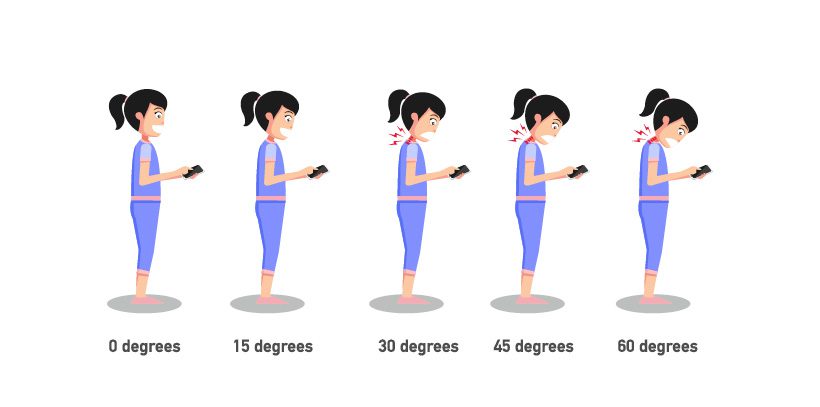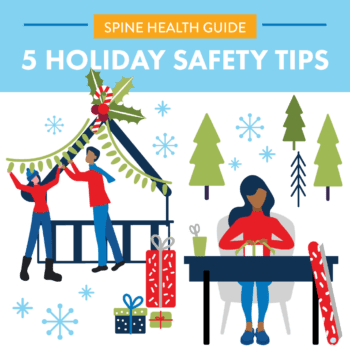
Backpacks and Text-Necks
An overwhelming number of Americans are awakening each day to upper back pain and neck stiffness, chronic ailments that can be a result of our neoteric lifestyle. Day-to-day life in the 21st century presents new, modernized “first world problems” that our predecessors didn’t suffer from. Two of the new-age culprits that cause chronic upper back and neck pain are the daily strain of carrying heavy backpacks and shoulder bags as well as the worldwide smartphone epidemic, which can lead to “text neck” or iPosture issues. “Text neck” is the term used to describe the neck pain and damage sustained from looking down at your cell phone, tablet, or other wireless devices too frequently and for too long. Let’s take a biomechanical look at each issue, why it causes damage to your spine, and explore methods we can employ to keep our spines healthy and happy in our modern society.
Backpacks
When carrying a backpack, the weight of the load is carried on the shoulders. Because the weight settles to the bottom of the bag, it strains the upper back and supportive muscles of the spinal column, causing neck and upper back pain. If this amount of strain and spinal compression continues each day, over time it can lead to long-term nerve damage. The skeletal structure of the spine is very delicate, with nerves passing through vertebrae. Any damage caused to nerves from being compressed by a heavy weight can last temporarily or can lead to more permanent chronic ailments. A backpack can easily weigh upwards of 20 pounds, which places constant load and compression along the spine. This can potentially lead to the cervical vertebrae impinging on the nerves that run from the neck, across the shoulders, and down the front of the arms. This is a risk for both adults, who routinely carry backpacks as well as college, high school, and elementary school students who carry heavy backpacks each day. If this is repeated for days, weeks, months, and so on, it is easy to see how this could cause long-term back problems and considerable medical bills to treat the numbness and loss of motor control caused by nerve damage.
Text-Neck
Similarly, imagine the neck strain caused by looking at our handheld wireless devices for hours each day. The human head weighs about a dozen pounds. However, as the neck bends forward and down, as it does while texting, emailing, or surfing the web, the weight on the cervical spine begins to increase. At a 15-degree angle, the head’s weight is about 27 pounds, at 30 degrees it is 40 pounds, at 45 degrees it is 49 pounds, and at 60 degrees it weighs a whopping 60 pounds! Imagine carrying an 8-year-old around your neck several hours per day. Smartphone users spend an average of two to four hours per day hunched over, reading e-mails, sending texts, or checking social media sites. That is 700 to 1,400 hours per year that people are putting stress on their spines, according to current research published by Kenneth Hansraj in the National Library of Medicine. According to Hansraj, “As you stretch the neck tissue for a long period of time, it gets sore, it gets inflamed. It can also cause muscle strain, pinched nerves, herniated disks and, over time, it can even remove the neck’s natural curve.” Poor posture can cause other problems as well, such as reduced lung capacity, headaches, neurological issues, even heart disease and depression.
The Solution
So how can we combat the habits of our daily lifestyle that can be potentially damaging our spine and overall health? Prevention, mindfulness, and developing core strength and flexibility are essential. A good backpack should fit correctly and have several pockets and zippered areas so that the weight of the contents can be distributed more evenly. The best ones also have a strap that latches across the chest, pulling the pack forward and reducing some of the weight in the shoulder area. The shoulder straps should be wide and well-padded to cushion the shoulder area and reduce pain from pressure. Load the backpack with the lightest items on the sides and top and restrict the number of heavy items carried in the bottom. Reduce the weight by carrying only what is needed for the day. Make sure the backpack is the right size for the user. It’s tempting to use a larger bag because it holds more items, but it also adds more weight.
We know modern technology is here to stay, so how can we continue to use our smartphones and wireless devices without causing long-term harm to our spines? Individuals should make an effort to look at their phones with a neutral spine and to avoid spending hours each day hunched over. Look down at your device with your eyes, there’s no need to bend your neck and compress your cervical spine. “I love technology. I’m not bashing technology in any way,” says Hansraj. “My message is: Just be cognizant of where your head is in space. Continue to enjoy your smartphones and continue to enjoy this technology — just make sure your head is up.”
Routine and consistent exercise and stretching plays a large role in preventative spinal health. Many people don’t know this, but you need to have strong core muscles—the abdominal and spinal column muscles—to support your upper body, including your neck. Your core muscles usually do not get enough exercise during normal daily activities, so you need to do specific exercises to target these muscles. You also need strong and flexible muscles in the neck and back to minimize strain on your cervical spine and help support the weight of your head. Again, your neck will not get sufficient stretching and strengthening during normal daily activities, so it is best to learn specific neck exercises with the help of a health professional. By keeping a strong, healthy core and being mindful in your biomechanics and daily habits, you can continue enjoying your busy life in the 21st century, all while maintaining a healthy, happy spine and body.
This article was originally published in the Spring 2016 journal.

Melissa Treat, RN, BS, CPT
Tysons Sport & Health


